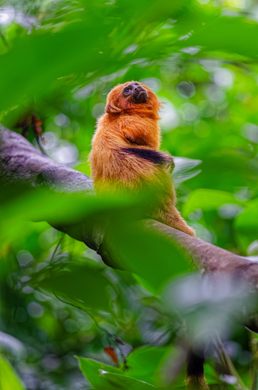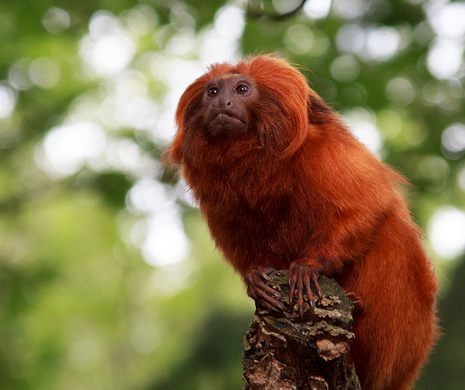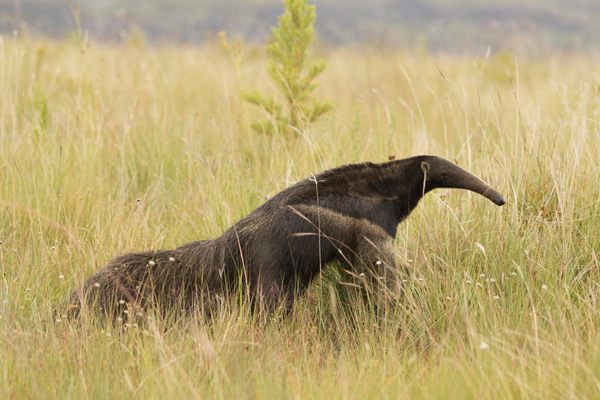AO Edited
The Golden Lion Tamarins of Poço das Antas
These small, spectacular monkeys are making a comeback after deforestation destroyed much of their rainforest habitat.
A mere hour or so away from the concrete jungle of Rio de Janeiro is a verdant rainforest reserve that is notable for being the last stronghold of one of the most endangered primates on earth: the dazzling little golden lion tamarin.
The golden lion tamarin is a species endemic to the state of Rio, meaning that it’s the only place in the world these animals can be found in their native habitat. They inhabit the Atlantic Forest and live in small family groups which center around a monogamous adult breeding pair and their offspring. These miniature monkeys are omnivorous, feeding mostly on fruits and insects. But they are also prolific hunters of reptiles, amphibians, and even on occasion small birds, which they catch with long claws before dispatching via a swift bite to the head.
The regal name of this pint-sized primate can be traced back to Portuguese colonists of the 15th century, who thought that the monkey’s magnificent golden mane gave it a decidedly leonine look. The arrival of the Portuguese in Brazil in 1500 would lead to the untrammeled destruction of the Atlantic Forest through logging, agricultural conversion, and urbanization, as colonial settlements and the human population continued to grow.
Golden lion tamarins became a prime target for animal trafficking throughout the 19th and 20th centuries, when they were sold as pets to local and foreign collectors as well as zoos in other countries. Due to these unrelenting pressures, by the 1960s the golden lion tamarin had experienced such a dramatic decline that it had disappeared almost entirely from the state of Rio. Only a tiny population remained in the wild in the forests of the Poço das Antas region.
Due to the severity of the situation facing the species, conservationists sprang into action. In 1971, Poço das Antas was declared the first reserve in Brazil to protect the remaining wild population. Carefully-managed insurance populations of tamarins were established in zoos throughout Europe and the United States to bolster the species’ numbers.
The 1980s and 1990s saw several successful reintroductions. Zoos in the U.K. and the U.S. sent tamarins sent to Brazil, where they were first habituated to life in the forest and then released back into the wild to increase the size and genetic diversity of the reserve’s population.
Today, the golden lion tamarin remains the subject of an intensive conservation programme both in-situ in the Poço das Antas reserve and ex-situ (in captivity) in zoos around the world. But this iconic species is far from being out of the danger zone.
In the 2010s, the mosquito-borne yellow fever virus began spreading across southeastern Brazil and infecting wild monkey populations, causing mass mortality across numerous national parks. The golden lion tamarin was one of the most badly-affected species—it’s estimated that the tamarin population of Rio de Janeiro state declined by approximately 32 percent during this period because of the virus. Thankfully, things have improved since then. Conservationists have developed a yellow fever vaccine that is being administered to wild golden lion tamarin groups, vastly improving the survivorship of these striking little monkeys.
Know Before You Go
Guided visits to the reserve may be booked through the Associação Mico-Leão-Dourado (Golden Lion Tamarin Association).
Trips last approximately four hours with visitors accompanying a conservation biologist of the AMLD NGO ( Associação Mico-Leão-Dourado) to radio-track groups of golden lion tamarin and see the animals at close quarters.
Visits to the reserve can be a bit pricey, however, the money spent on a trip goes directly to efforts to conserve the species in the wild (an expensive endeavor).
Visitors to Pouco-das-antas must present certification of yellow fever vaccination to the park authorities upon entering the reserve.

















Follow us on Twitter to get the latest on the world's hidden wonders.
Like us on Facebook to get the latest on the world's hidden wonders.
Follow us on Twitter Like us on Facebook